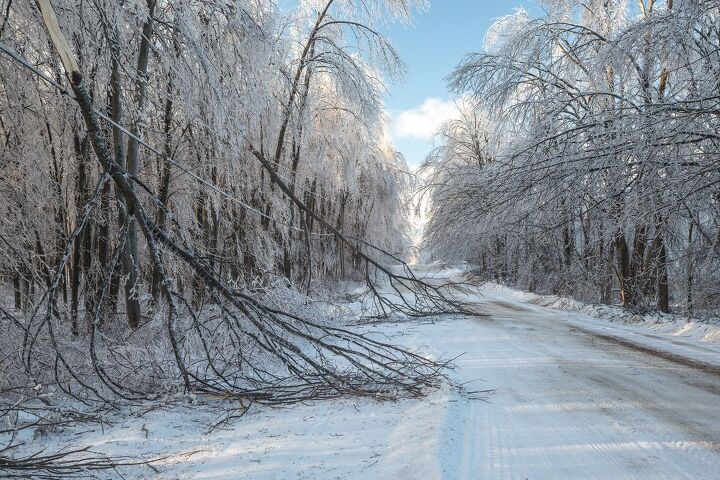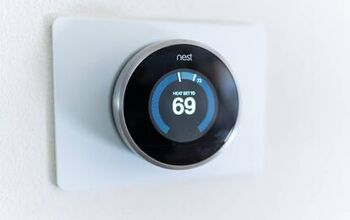10+ Alternative Heat Sources For Power Outages

Winter storms are no joke. They can bury your home in snow and ice and leave you snowed in and stranded. These storms can carry with them winds and low temperatures that can weigh down power or snap lines and force trees to the ground, causing your power to go out. Being stranded in a winter storm with no power is not only inconvenient, it can be altogether dangerous. As you prepare your home for a winter storm, you should have some alternative heating methods ready in case you lose power.
When you lose power, try heating your home using classic heating methods like a wood fire in your fireplace, hot stones, or by layering up and creating a heating room. Consider purchasing a fuel-based heater that uses propane or kerosene. You can also install a gas fireplace. If you have a generator, power a circuit and run an electrical heater, or you can purchase a battery-operated heater.
If you lose power in the winter, there are all sorts of alternative heating methods available. You might even have access to some of these methods already. This means you won’t need to head to a local hardware store to purchase equipment. Otherwise, there are many ways to heat your home, using different sources of power, and also available at different price points. Read below to learn more about some of the best alternative heating methods in order to find out what works best for your home should you lose power on a cold day.
11 Heating Options To Try During Power Outages
1. Propane Heater
One of the most popular heating methods to use when electricity is not an option are propane heaters. In fact, you probably see them all the time, heating up outdoor restaurant terraces as the temperatures begin to decline. Propane heaters come in all shapes and sizes, and can be a great option to have on hand in case of a power outage.
For one, propane heaters are often very affordable. Due to their increasing popularity, there are lots of options, which helps drive down the cost. Additionally, propane is a very easy fuel to purchase, and most people have at least one propane tank on hand for summer grilling purposes. This means you simply have to keep that tank (or tanks) filled in the winter in case you lose power.
Propane heaters are also energy efficient, meaning the fuel burned almost all goes towards heating your home (up to 99% in newer models). Just make sure you follow all safety instructions properly. They should be far away from anything flammable, and are often best in the middle of rooms, far away from walls. Some propane tanks can deplete oxygen, so be sure your room is ventilated and you take proper precautions.
2. Utilize Your Fireplace
One of the best (and possibly romantic) heating methods is to use your existing wood fireplace. While fireplaces and pellet stoves are largely ornamental and installed for aesthetics, for thousands of years they were how most people warm and alive throughout the winter.
If you have a wood fireplace or pellet stove make sure you properly maintain it. This is especially important if you plan to utilize it during a power outage. You need to clean your fireplace regularly. Make sure the chimney is also maintained and is in working order. These types of maintenance should be done regularly. They will help your fireplace last longer, and ensure that it will work safely in the event that you cannot use electricity to heat your home.
Since fireplaces and pellet stoves require wood, you need to make sure you have plenty of this going into the cold months. Keep ample chopped and covered wood nearby so you can access it even if there was a winter storm.
3. Use Your Generator
Generators can be a literal (and figurative) life saver when you lose power. They can make sure you have food and means to cook it. They can even help you keep your home warm. If you have a power outage, a generator likely does not have the strength (at least not for long) to run your entire electrical heating system. It should, however, have the means to run an electrical heater from time to time.
If you have a generator and an electric heater, you can run them both, and heat at least one or two rooms in your home while you wait for the power to return. As is always the case with generators, it is crucial you keep it at a safe distance for the home to prevent carbon monoxide poisoning and other potential issues. If you are running your generator when there is a winter storm, make sure it is protected from the elements.
4. Battery-Operated Heaters
Believe it or not, you don’t need a big can of fuel to run a heater. Some heaters, thanks to modern technology, are battery run. There are various types of battery-operated heaters. Some work better than others. The best battery operated heaters might cost you a pretty penny, but they are also more likely to hold a charge longer. They are also normally more effective at heating your room than cheaper models.
If you live in a smaller space like an apartment, fireplaces, generators and propane heaters might not be a viable option. A small yet effective battery-operated heater might be a good investment for you if this is the case. Just be sure to read reviews and understand its capacity and safety guidelines before making the purchase.
5. Install A Gas Fireplace
If you have a more modern home it may not have a functional wood fireplace. After all, functional fireplaces have lost their necessity, and are more there for decoration and enjoyment in the winter months. You might not need a wood fireplace, but you might want to consider installing a gas fireplace.
A gas fireplace is a great way to create ambiance and heat without needing to lug wood into the house and tend a fire. Installing a gas fireplace can be a bit pricey, but they serve several functions, including keeping you warm when the power goes out. You should also keep in mind that while they are a large initial financial investment, they often add property value to your home. In other words, you might be able to get the money back – and then some.
6. Kerosene Heater
Another fuel-burning heat option to consider is a kerosene heater. Kerosene heaters often work similarly to propane heaters. They, like propane heaters, are a popular option for when electricity is not available. Kerosene is an efficient fuel, and can often heat a room even more effectively than propane.
Like propane, kerosene heaters can be dangerous. Make sure they are in a well-ventilated room, as they give off levels of carbon monoxide. Choose kerosene heaters that are meant for indoor use. Remember also that kerosene is more expensive than propane and not as readily available. This means you should make sure you have enough kerosene on hand going into winter storm season.
7. Use Burner Cans
If you have a small space to heat, or need a last minute and inexpensive option, you can try using burner cans to heat your home during a power outage. Burner cans like the name brand Sterno are great to have in any emergency readiness kit. They provide fuel for cooking, and can even heat a room a bit in a bind.
Burner cans are not exactly an ideal heat source, but if used properly can be effective in an emergency. You can use several cans to heat a small room. This should increase several degrees in temperature, keeping you out of more dangerous cold temperatures. They are also inexpensive.
Keep in mind, however, that these cans last anywhere from 2 for 4 hours. This means you should have at least a full case on hand to ensure you can heat a room and possibly cook, for at least a couple days.
8. Hot Stones
Another heating method that has been successful for thousands of years is the use of hot stones. This method involves having an outdoor fire. Using an outdoor fire pit works well. Place the hot stones in the fire for an hour or longer, and remove them with fire tongs, placing them in a designated bucket or clay pot. They will give off heat in a room for some time.
As they cool to safer temperatures. When you are heating your stones, you can also use the fire to do a bit of cooking, since you likely don’t have the means to do much cooking (unless you have a gas stove).
9. Catalytic Heater
Catalytic heaters are another option for those looking to purchase a heating device for times when the power goes out. These heaters use heat or natural gas to transfer this fuel into heat. Unlike the propane and kerosene heaters mentioned previously Catalytic heaters transform the gas into heat without an open flame.
These heaters can be effective. It is critical, however, that you make sure you purchase a catalytic heater that is designed for indoor use, as not all are. Just like with any heating method using fuel and requiring oxygen intake, these heaters need a well-ventilated room. Always check safety guidelines to ensure you are not putting yourself at risk.
10. Heating Pads And Hand Warmers
If you have an emergency kit, you should always make sure you have some heating pads and hand warmers inside it. Hand warmers and larger heating pads are common on cold hikes, and on cold days at winter football games. They are also great for emergency preparedness in times when you have no access to heat and it is very cold outside.
Heating pads and hand warmers are temporary fixes, and they often don’t last longer than a few hours, so be sure you have ample warmers to last you a few days as needed.
11. Create A Designated Heating Room & Layer Up
When all else fails, or in addition to all your other attempts to heat your home without electricity, you can always use your body heat to stay warm. As soon as you notice the power has gone out during a winter storm, bundle up, and choose at least one room in the house you want to keep warm. A well-insulated but also well-ventilated room is the best and safest option. This will conserve and make best use out of all your alternative heating methods until the power comes back on.
Wrapping Up Alternative Heat Sources For Power Outages
As you prepare for a winter storm, one of the most important variables for you to get ready for is a power outage and loss of heat. If you have a wood or gas fireplace, you can use these to increase the temperature in your home.
Alternatively, you can purchase a kerosene or propane heater for occasions like these. You can also try using burner cans, hot stones and heating pads while layering up to conserve your body heat. If you have a generator, you can use it to power a circuit enough to occasionally run a space heater in a designated heating room.

Tom Gaffey is an expert writer who currently resides in Washington D.C. Tom has a passion for real estate and home improvement writing, as well as travel and lifestyle writing. He lived the last twelve years in Hawaii where he worked closely with luxury resorts and event planners, mastering his knowledge of aesthetics and luxury products. This is where he found his passion for home improvement and a keen interest in DIY projects. Currently, Tom resides in Washington D.C, and also working on his debut fiction novel.
More by Tom Gaffey




















![Cost To Drill A Well [Pricing Per Foot & Cost By State]](https://cdn-fastly.upgradedhome.com/media/2023/07/31/9074980/cost-to-drill-a-well-pricing-per-foot-cost-by-state.jpg?size=350x220)






